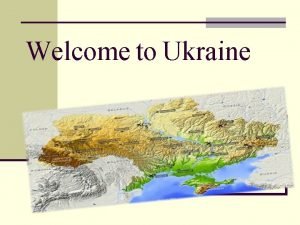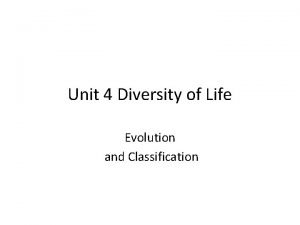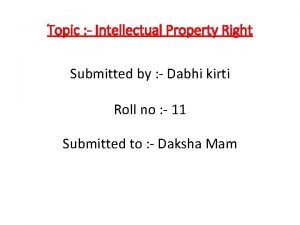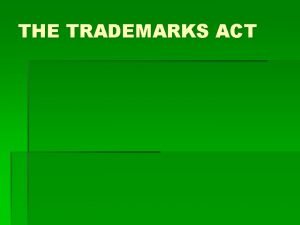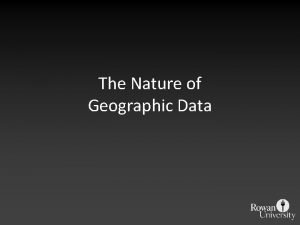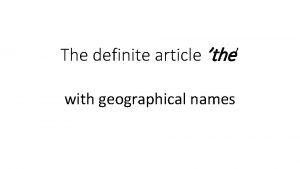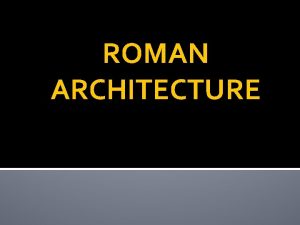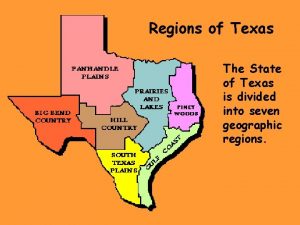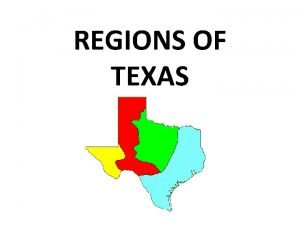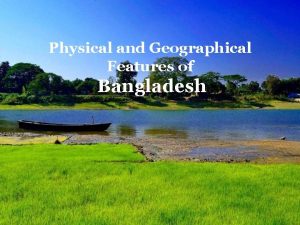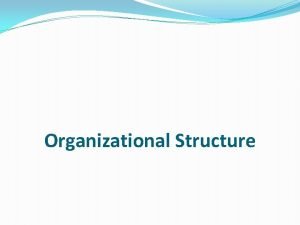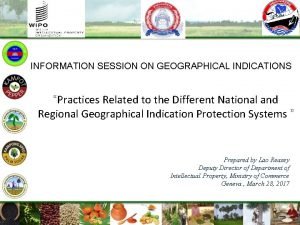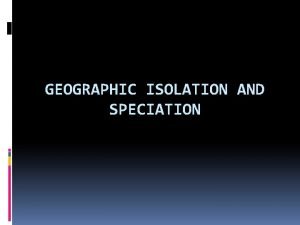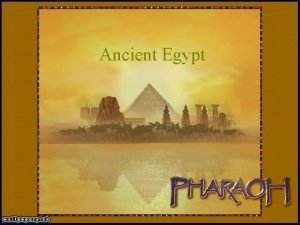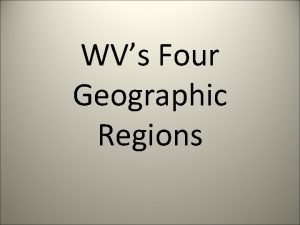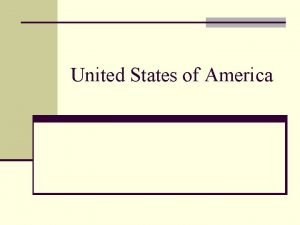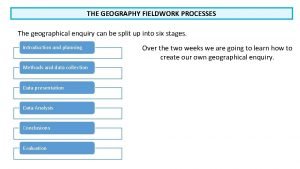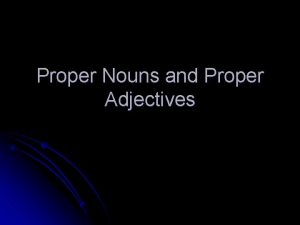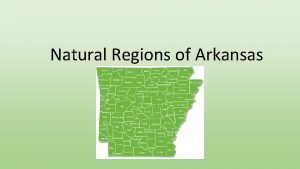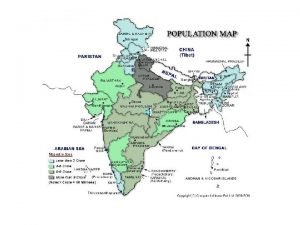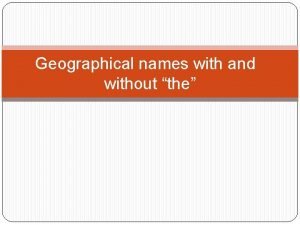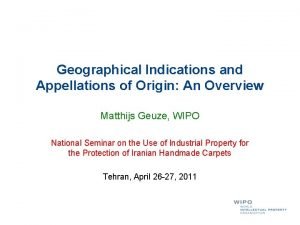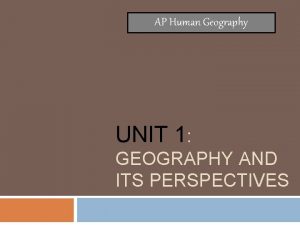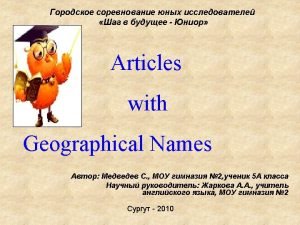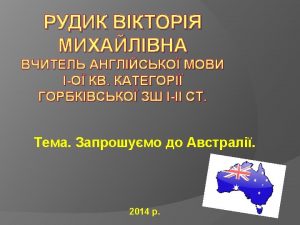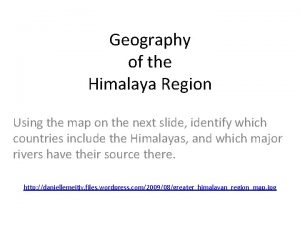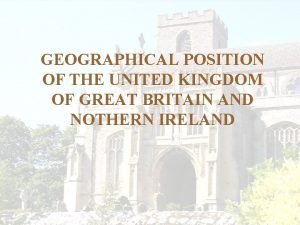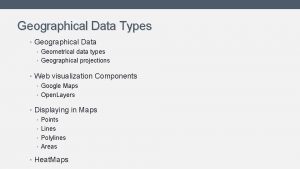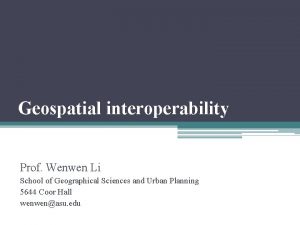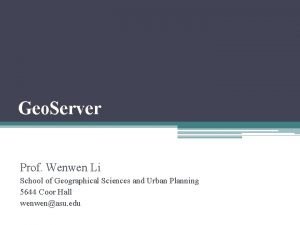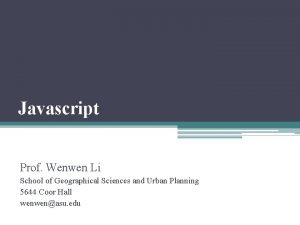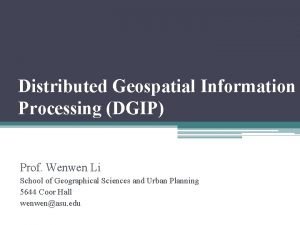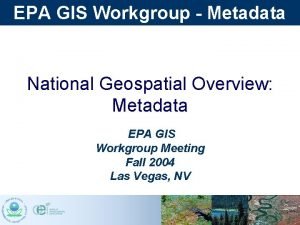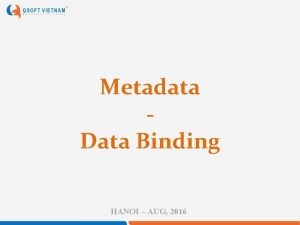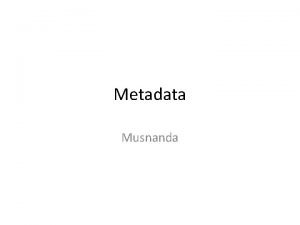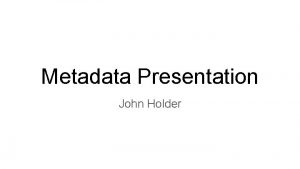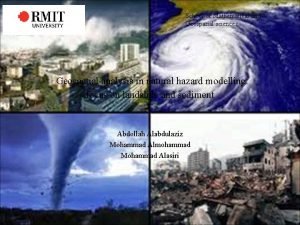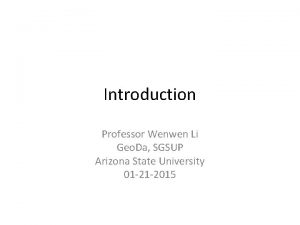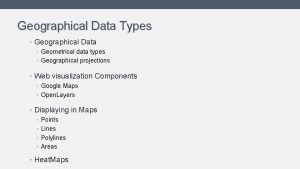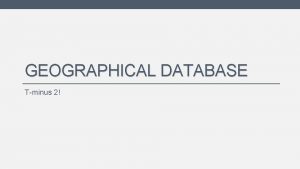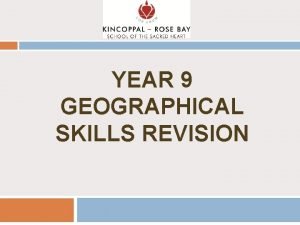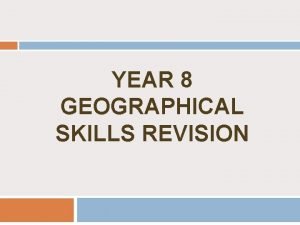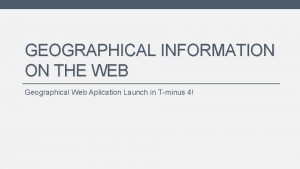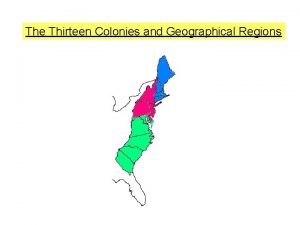Geospatial metadata Prof Wenwen Li School of Geographical


































- Slides: 34

Geospatial metadata Prof. Wenwen Li School of Geographical Sciences and Urban Planning 5644 Coor Hall wenwen@asu. edu

Outline 1. Metadata 2. Main organizations of geospatial metadata 3. Metadata syntaxes 4. Geospatial metadata standards 5. Application & contrast 6. Summary

Metadata is the data describes the content of other data, including: • Who created the data? • What is the content of the data? • When was it created? • Where is it geographically? • How was the data developed? • Why was the data developed?

Main organizations of geospatial metadata • International Organization for Standardization (ISO) • Federal Geographical Data Committee (FGDC) • Dublin Core Metadata Initiative (DCMI)

Main organizations of geospatial metadata International Organization for Standardization (ISO) Develop and publish international standards, which ensure that products and services are safe, reliable and of good quality. ISO for geography: ISO/TC 211 - Geographic information/Geomatics http: //www. iso. org/iso/home/store/catalogue_tc_browse. htm? commi d=54904&published=on * http: //www. iso. org/iso/home. html

Main organizations of geospatial metadata Federal Geographical Data Committee (FGDC) The Federal Geographical Data Committee (FGDC) currently supports multiple metadata standards. • The Content Standard for Digital Geospatial Metadata (CSDGM) is the long time FGDC endorsed geographic metadata standard. • The U. S. is in the process of adopting and implementing the International Standards Organization (ISO) geographic metadata standard (19115). * https: //www. fgdc. gov/library/factsheets/documents/Geospatial. Metadata-July 2011. pdf

Main organizations of geospatial metadata Dublin Core Metadata Initiative (DCMI) The Dublin Core Metadata Initiative (DCMI) is an open organization focusing on shared innovation in metadata design and best practices across a broad range of purposes and business models. The metadata is currently characterized in terms of four "levels" of interoperability: • Level 1 (Shared term definitions): based on shared natural-language definitions. • Level 2 (Formal semantic interoperability): based on the shared formal model provided by RDF, which is used to support Linked Data. • Level 3 (Description Set syntactic interoperability): share an abstract syntax for validatable metadata records, the "description set". • Level 4 (Description Set Profile interoperability). a common set of constraints use the same vocabularies and reflect a shared model of the world. * http: //dublincore. org/about-us/

Metadata syntaxes • Hypertext Markup Language-HTML • e. Xtensible Hypertext Markup Language-XHTML • Extensible Markup Language-XML • Resource Description Framework-RDF

Metadata syntaxes HTML • Current standard: HTML • HTML is an SGML (Standard Generalized Markup Language) application conforming to International Standard ISO 8879 • The popular standard language for the World Wide Web • HTML addresses the problem of SGML complexity • HTML sets structural and semantic tag for simple documents XHTML • To make HTML to match XML syntax • XHTML is a W 3 C specification • XHTML redefines HTML as an XML implementation, rather than an SGML implementation • XHTML intends to create more well-formed XML, easier for browsers

Metadata syntaxes HTML & XHTML

Metadata syntaxes XML • • A ‘metamarkup’ language XML has no fixed tags or elements Strict grammar imposes structure designed to be read by machines Two levels of conformance including general grammar rules, and particular XML schema • Web 2. 0 application is based on XML

Metadata syntaxes RDF • • • A language for describing resources for the web Structure based on “triples” Exchange of information between different kinds of organizations and usages An essential part of the Semantic Web Can be integrated with XML

Geospatial metadata standards • FGDC Endorsed ISO Metadata Standards • Content Standard for Digital Geospatial Metadata (CSDGM) • Dublin Core Metadata Initiative (DCMI)

Geospatial metadata standards FGDC Endorsed ISO Metadata Standards* • ISO 19115: The base ISO metadata standard for the description of geographic information and services. Expected to be replaced by ISO 19115 -1. • ISO 19115 -2 is the preferred standard for organizations actively implementing ISO Metadata as it includes all of the elements of ISO 19115 as well as additional elements that are relevant to many geospatial data sets. • ISO 19110: An affiliate standard that supports the detailed description of feature types in a manner similar to the CSDGM Entity/Attribute Section. The standard can be used in conjunction with ISO 19115 to document geospatial data set feature types or independently to document data models or other feature class representations. • ISO 19119: Extensions of the service metadata model An affiliate standard that supports the detailed description of digital geospatial services including geospatial data portals, web mapping applications, data models and online data processing services. The standard can be used in conjunction with ISO 19115 to document services associated with a specific data set/series or independently to document a service. * https: //www. fgdc. gov/metadata/geospatial-metadata-standards#whichisometadatastandards

Geospatial metadata standards FGDC Endorsed ISO Metadata Standards* • ISO 19139 is an XML schema that specifies the format of the metadata record and is used by application developers to implement the standard. • The North American Profile (NAP) of ISO 19115 is applied due to the broader scope of ISO 19115 -2. However, the NAP does provide a rich source of best practices as well as strengthened conditionality and expanded domains that are used by many ISO implementers. • ISO 19115 -1 was developed after ISO 19115 -2. ISO 19115 -1 expands upon the former standard by providing more fields to describe geospatial data services (ISO 19119), multi-dimensional gridded datasets, modeling results, etc. , and enabling entity/attribute descriptions developed using ISO 19110: Feature Catalog to be associated with or integrated into the metadata record. * https: //www. fgdc. gov/metadata/geospatial-metadata-standards#whichisometadatastandards

Geospatial metadata standards

Geospatial metadata standards Components of a metadata record (FGDC Endorsed ISO Metadata Standards)* Metadata Record Information: information about the metadata record. • The language in which the record is written • The unique file identifier for the metadata record • The metadata standard used to organize the record • A point of contact for the metadata record • The date that the metadata record written. Identification Information: citation-level information about the data • Title • Abstract • Purpose for creation • Status • Keywords (theme and place) • Extent (temporal, vertical and horizontal). * https: //www. fgdc. gov/library/factsheets/documents/Geospatial. Metadata-July 2011. pdf

Geospatial metadata standards Components of a metadata record (FGDC Endorsed ISO Metadata Standards)* Constraints Information: information about legal and security limitations to data access and use. Data Quality Information: information about the processes and sources used to develop the data and positional and/or accuracy assessments performed. Maintenance Information: information about the scope and frequency of data updates. Spatial Representation: information about the mechanism used to represent spatial data (grid, point, vector). Reference System Information: information about the reference systems used to represent geographic position and time. * https: //www. fgdc. gov/library/factsheets/documents/Geospatial. Metadata-July 2011. pdf

Geospatial metadata standards Components of a metadata record (FGDC Endorsed ISO Metadata Standards)* Content Information: information about the data set entities and attributes. Symbology Information: information about the symbols used to represent spatial features. Distribution Information: information about the data distributors and methods for obtaining the data. Metadata Extension Information: information about custom, user-based, changes to the elements, domains or conditionality of the standard. Application Schema Information: information about the schema or data models used to structure the data. * https: //www. fgdc. gov/library/factsheets/documents/Geospatial. Metadata-July 2011. pdf

Geospatial metadata standards Components of a metadata record (FGDC Endorsed ISO Metadata Standards)* * https: //www. fgdc. gov/library/factsheets/documents/Geospatial. Metadata-July 2011. pdf

Geospatial metadata standards Content Standard for Digital Geospatial Metadata (CSDGM)* * http: //www. fgdc. gov/metadata/csdgm/

Geospatial metadata standards Content Standard for Digital Geospatial Metadata (CSDGM)* Identification Information: basic information about the data set. * http: //www. fgdc. gov/metadata/csdgm/

Geospatial metadata standards Content Standard for Digital Geospatial Metadata (CSDGM)* Data Quality Information: a general assessment of the quality of the data set. * http: //www. fgdc. gov/metadata/csdgm/

Geospatial metadata standards Content Standard for Digital Geospatial Metadata (CSDGM)* Spatial Data Organization Information: the mechanism used to represent spatial information in the data set. * http: //www. fgdc. gov/metadata/csdgm/

Geospatial metadata standards Content Standard for Digital Geospatial Metadata (CSDGM)* Spatial Reference Information: • the description of the reference frame • the means to encode • coordinates in the data set * http: //www. fgdc. gov/metadata/csdgm/

Geospatial metadata standards Content Standard for Digital Geospatial Metadata (CSDGM)* Entity and Attribute Information: details about the information content of the data set • the entity types • the attributes • the domains from which attribute values may be assigned. * http: //www. fgdc. gov/metadata/csdgm

Geospatial metadata standards Content Standard for Digital Geospatial Metadata (CSDGM)* Distribution Information: information about the distributor of and options for obtaining the data set * http: //www. fgdc. gov/metadata/csdgm/

Geospatial metadata standards Content Standard for Digital Geospatial Metadata (CSDGM)* Metadata Reference Information: information on the currentness of the metadata information, and the responsible party. * http: //www. fgdc. gov/metadata/csdgm/

Geospatial metadata standards Dublin Core Metadata Initiative (DCMI)* Contributor: an entity responsible for making contributions to the resource Coverage: the spatial or temporal topic of the resource Creator: the entity primarily responsible for making the resource. Date: a point or period of time associated with an event in the life cycle of the resource. Description: the explanation of the resource, which include an abstract, a table of contents, a graphical representation, or a free-text account of the resource. Format: the file format, physical medium, or dimensions of the resource. * http: //www. geomapp. net/docs/Metadata. Comparison_200903. pdf

Geospatial metadata standards Dublin Core Metadata Initiative (DCMI)* Identifier: An unambiguous reference to the resource within a given context Language: Language of the resource Publisher: an entity responsible for making the resource available. Relation: a related resource Rights: information about rights held in and over the resource. Source: A related resource from which the described resource is derived. Subject: The topic of the resource. * http: //www. geomapp. net/docs/Metadata. Comparison_200903. pdf

Geospatial metadata standards Dublin Core Metadata Initiative (DCMI)* Subject: the topic of the resource Title: a name given to the resource Type: the nature or genre of the resource * http: //www. geomapp. net/docs/Metadata. Comparison_200903. pdf

Application & Contrast Study sample Subject: the topic of the resource Title: a name given to the resource Type: the nature or genre of the resource * http: //www. geomapp. net/docs/Metadata. Comparison_200903. pdf

Examples • XML segment to encode the same content using different standards • (online) Tools for metadata conversion

Summary Study sample Subject: the topic of the resource Title: a name given to the resource Type: the nature or genre of the resource * http: //www. geomapp. net/docs/Metadata. Comparison_200903. pdf
 Wenwen li
Wenwen li The geographical position of ukraine
The geographical position of ukraine Geographic isolation examples
Geographic isolation examples Registration process of geographical indication
Registration process of geographical indication Registration of geographical indication
Registration of geographical indication Southeast region physical features
Southeast region physical features Nature of geographic data
Nature of geographic data Definite article with geographical names
Definite article with geographical names Geographical influence on architecture
Geographical influence on architecture Geographical regions of texas
Geographical regions of texas Great plains texas landforms
Great plains texas landforms Bangladesh physical features
Bangladesh physical features Geographical divisional structure
Geographical divisional structure Stage 5 geography syllabus
Stage 5 geography syllabus Registration process of geographical indication
Registration process of geographical indication What is geographic isolation
What is geographic isolation Location
Location Greece geography
Greece geography Geographical map of ancient egypt
Geographical map of ancient egypt Allegheny highlands ethnic groups
Allegheny highlands ethnic groups What is the geographical position of the united states
What is the geographical position of the united states What is geographical enquiry
What is geographical enquiry Geographical nouns
Geographical nouns Arkansas geographic regions
Arkansas geographic regions Geographical position has given india
Geographical position has given india Continents without names
Continents without names Indications and appellations of origin
Indications and appellations of origin Geographical data ap human geography
Geographical data ap human geography Test articles with geographical names
Test articles with geographical names Australia geographical position
Australia geographical position Various forces behind management thought
Various forces behind management thought Geographical map of himalayas
Geographical map of himalayas What geographical feature usually distinguishes time zones?
What geographical feature usually distinguishes time zones? Great britain geographical position
Great britain geographical position Geographical data types
Geographical data types

